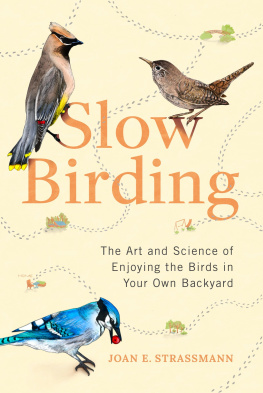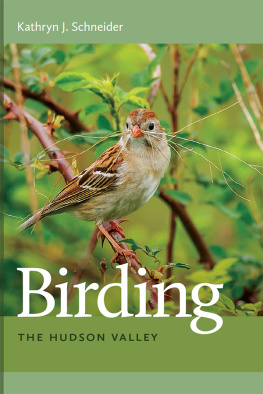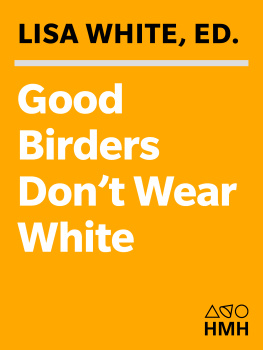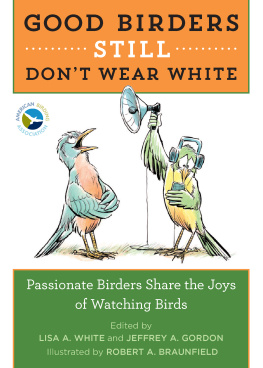
Table of Contents

Copyright 2007 by Houghton Mifflin Company
Illustrations copyright 2007 by Robert A. Braunfield
Foreword copyright 2007 by Pete Dunne
All rights reserved
For information about permission to reproduce selections from this book, write to Permissions, Houghton Mifflin Harcourt Publishing Company, 215 Park Avenue South, New York, New York 10003.
www.hmhco.com
The Library of Congress has cataloged the print edition as follows:
Good birders dont wear white : 50 tips from North Americas top birders.
p. cm.
Includes bibliographical references.
ISBN -13: 978-0-618-75642-1
ISBN -10: 0-618-75642-6
1. Bird watching. I. Houghton Mifflin Company.
QL677.5.G64 2007
598.072'34dc22
2006030503
e ISBN 978-0-547-34485-0
v2.0414
Foreword
I FIND MYSELF IN A VERY uncomfortable position hereand I dont mean facing a computer screen with fingers dancing over the keyboard. Fact is, I write a lotbooks, articles, columns, you name it. If the topic relates directly or tacitly to birds, chances are Ive dabbled in it. No, my discomfort has nothing to do with any unfamiliarity. It has to do with direction.
Almost always, when I sit down to write, I know precisely what Im going to say and pretty much how Im going to say it. This time Im at a loss. I know what Im supposed to do, and that is warm up readers for the great act to follow. But that is also the problem. How can any one writer hope to introduce a birding audience to the greatest compilation of birding know-how of all time?
Okay, lets start with what this foreword is not going to do. It is not going to beguile you with the hints, tricks, shortcuts, and advice that expert birders bring to bear. That is what the fifty contributors to this book have done: synthesize more than a hundred years of birding tradition and approximately twenty-five hundred cumulative years of birding experience.
Whos going to try to compete with that?
This foreword is also not going to fall back on the old tried-and-true distraction employed by many writers in my position, which is to expound on my own experiences with birds, birding, and bird study.
Look. Ive written whole books filled with anecdotal bird stuff like that. You passed them by in order to buy this one (and I cant gainsay your choice).
But in searching for an angle, I do find that I have an insiders insight that may pique a readers interest. It turns out that I know virtually all of the contributors to these pages, recognizing all as colleagues and knowing many as friends. Many writers have an aversion to speaking about themselves, so with the authority vested in me, I think it might be fun to offer readers a peek behind the writers mask and direct a descriptive word or two toward the contributing authors of Good Birders Dont Wear White.
Jon Dunn is a noted author and tour leader for WINGS and has been for many years the final word when it comes to tricky identifications. All photos of unidentified gulls and Empidonax flycatchers with borderline traits ultimately find their way into Jons hands. Jon is affable and serious, intellectually gifted, and boasts an array of interests (we share a passion for American history). Tens of thousands of birders are better birders because of Jon and his teaching skill. If you are not counted among them, you soon will be.
Jessie Barry, at the tender age of thirteen, was a poster child for the American Birding Association. She and I appeared together in their membership brochure. The photo showed me pointing out a bird, Jessie looking on. Ive always wanted to know what happened to the other hundred photos taken that daythe ones that showed Jessie pointing out birds to me. As memory serves, they were more representative of our day. Now that she is at the University of Washington, working on a degree in ecology and evolutionary biology and in her spare time on a field guide to North American waterfowl, Jessies signature expression is Uhmmmm. When she starts humming this mantra, it means her binoculars are fused to something really good andyoubettergetonitFAST.
The last time I heard it, she was looking at a Summer Tanager from the porch of the person who claims the largest yard list in North America. The bird proved to be number 307 for Paul Lehman, a Cape May resident celebrated for his knowledge of bird distribution. Open almost any field guide. If Paul didnt actually draft the range maps, he was almost certainly consulted. His hobby is finding new bird species for North America. His happy hunting ground is the Inuit village of Gambel on St. Lawrence Island. I dont know whether Paul has actually been adopted by the tribe, but he is on the tribal leaders e-mail birthday greeting list.
Pauls yard list total now? Just hit 314. Magnificent Frigatebird. As fortune had it, he was away from home last week, when the Gray Kingbird perched on the utility lines just down the street from his porch. Yep, you guessed it, Paul was on Gambel.
When it comes to just plain enjoying birds, few can stand on the same platform with Victor Emanuel, founder and director of Victor Emanuel Nature Tours. Victors signature expression is Wow. Search the world over, and youll find nothing that beats Wow. But what distinguishes Victor is not so much the expression as the lavishness with which it is applied. Victor says Wow about almost any bird. A White-eyed Vireo in full view garners a Wow. A Northern Cardinal in sunlight earns a Wow. A Painted Redstart, dancing through the oaks in Cave Creek Canyon (where Victor and I used to co-lead his youth birding camps) is always sanctified with a Wow. Often several.
And you know, no matter how many vireos or cardinals youve seen (and Ive seen hundreds), when Victor says Wow, by golly, you get that sense of wow, too. Wow is infectious. Victor the vector.
I cant begin to express how delighted I was to see John Krichers name ranked among the authors. I met John, a college professor and ecologist, in the summer of 1977. He was teaching a marsh ecology course; I was struggling to give standing and solvency to an institution called the Cape May Bird Observatory.
Not long ago I was working on a book project that involved reading virtually all of the 716 volumes that constitute The Birds of North America. This comprehensive ornithological work was designed to impart the sum of knowledge relating to North American birds and, as such, was never intended to make for light reading. But the intent didnt necessarily preclude this possibility, and while reading the account for Black-and-white Warbler, I was surprised by the entertaining and readable quality of the piece. I turned to the cover to see who the author was, and you guessed itJohns name was there. Scientist and wordsmithtwo great but by no means singular qualities.
This book will introduce you to other contributors who are both able scientists and capable communicatorsPaul Kerlinger, author and bird migration expert who did his seminal work on migrating raptors by using an old police radar in Cape May, and David Bird, McGill University professor and radio show host.
Its a slippery slope Ive placed myself on, realizing now that by singling out just some of the wonderful and talented contributors to this book, I will inevitably fail to do justice to them all.
It would be unthinkable not to draw the readers attention to Bill Thompson III, editor of Bird Watchers Digest and author of
Next page









